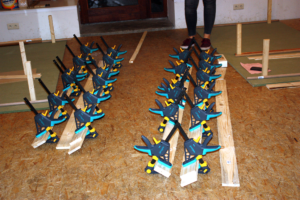(
continued from part 2)
I did hop into the car for a long drive to Belgium - because the next thing that happened was the European Textile Forum. To my utter delight!
The Textile Forum is my week of sheer and utter textile madness, and I missed it so much last year when it had to be cancelled due to the pandemic. It was a chance to take and plan for this year, but the stars lined up favourably, with a wonderful venue in Belgium that would have enabled us to cancel everything up to about two weeks before the Forum, if things should explode.
Fortunately, they did not.
First of all, let me introduce you to the house where we had our conference, called "Merveille de Méry". It's utterly beautiful, and spacious, and situated a bit above Tilff-Méry in the woods, so it's quite quiet and with lovely green surroundings.

Unfortunately, I didn't take any decent photos of the house itself - but you can
have a look at it on its own website (where you can also book it as a vacation home for up to 18 persons).
There was ample space in the garden for working, there was the multi-purpose room in the basement prepared with looms and tables for more weaving, and of course we spread out over the rest of the venue as well - the main room, where we had the presentations, and the balcony. At one point, there was a little abandoned bow loom sitting on the stairs late at night:

The topic of the week was "Sticks and Stones May Make a Loom", and being a non-weaver, I think this was the Forum where I did learn the most. It was absolutely amazing, and my weaving skills have increased a lot. They are still rather puny, I'm afraid - getting a lot better at something you have no real experience with is easily done while it may still let you end up in the "not very good at it yet" section.
I had a lot of fun, too.
Weaving included several weaver-tensioned trials, and I have finally understood, during that week, why you'd want to tie yourself to your piece of work. That had always been a mystery to me before. I will still use two fixed points for my tablet weaving in the future, but for bands or other types of weaving? Weaver-tensioned is definitely an option.
Basically, what weaver-tension weaving does for you is give you a lot of flexibility in your tension - and if you have mastered it, in a good way. You can reduce tension for some steps of the process, such as when you are changing sheds, and increase it for others, such as pressing in your weft, and this becomes an intricate and subtle dance with your tools and materials. It is absolutely fascinating to watch when someone does this well. It also means you can lessen the abrasion on your threads by only using as much tension as necessary for each step, and since that can differ, weaver-tensioning gives you the ability to use less tension overall.
Me, I'm still struggling with this intricate dance. I know, in theory, when I want to do what, but the movements are too big, too jerky, and my tension is usually either way too low or way too high. It is a question of fine-tuning the whole body fine motor skills, so to say... so maybe it's a good thing I have a full three items to practise on.




 Putting together the two uprights - since we had the luxury of a lot of clamps, we used them. The boards are glued together, and then secured additionally with a few screws.
Putting together the two uprights - since we had the luxury of a lot of clamps, we used them. The boards are glued together, and then secured additionally with a few screws. The upper part of the loom, with the square end of the round beam sitting nice and snug in the uprights. For the first test, another beam with a weave already attached was used - for "proper" weaving, you'd attach your weave to the beam directly or via a narrow slat or rod that the starting border has been stitched to.
The upper part of the loom, with the square end of the round beam sitting nice and snug in the uprights. For the first test, another beam with a weave already attached was used - for "proper" weaving, you'd attach your weave to the beam directly or via a narrow slat or rod that the starting border has been stitched to.

